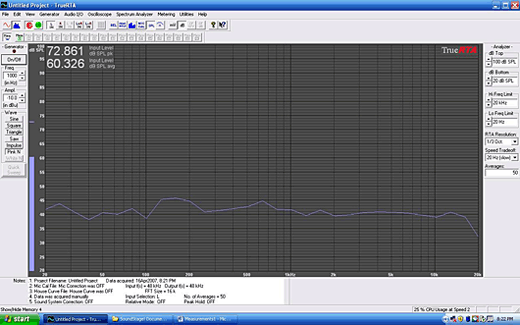 |
| July 1, 2007 Using Your Ears and a Microphone for Speaker Placement It’s an audiophile ritual: You get your new speakers home, unbox them, plop them down in the spots where your old speakers used to sit, and listen. Then you get up, perhaps move them a bit farther away from the front wall, and listen again. Then you get up, toe them in a bit, and listen yet again. The ritual goes on until you have everything just right and are completely satisfied with the sound. All right, maybe you’re never completely satisfied, but that’s the goal. Depending on the speakers you buy, the ritual might be a little less haphazard. First, the manufacturer or dealer might have already provided some solid recommendations of where the speakers might sound best in your room. Most manufacturers will know how much toe-in will sound best, for example, and dealers used to setting up speakers can draw on that experience for your benefit. Those who purchase a speaker system from a company such as Wilson Audio Specialties will get a trained setup technician to dial in the speakers for you. There’s more than one way to skin a cat, however. For the past year or so, I’ve been using in-room frequency-response measurements to help me find the proper speaker positions. This powerful tool has greatly simplified the dialing-in process, and made the results much closer to ideal than I could have gotten by listening alone. Here’s how the process works for me: I have a basic set of speaker positions that were determined when my room was originally designed by acoustic engineer Terry Montlick. These locations, chosen to minimize my room’s resonant modes, describe a nearly equilateral triangle with my listening position. The locations are far enough from my front wall to allow good soundstage depth to develop, but not so far that they push my listening seat up against the rear wall. I’ve marked these spots with tape, and they’re where I always begin when placing a new set of speakers. I begin by listening for several days in order to get a sense of how the speakers sound in those standard positions -- where any problems might lie, and which aspects of the sound are really good. Establishing a baseline through some initial listening is important; later on, you can relate back to how the speakers sounded in their initial positions. I then begin the measurement process. I use a program called TrueRTA (readily available online at www.trueaudio.com), a Behringer microphone coupled to a tripod with a boom, and my laptop. I use the 1/3-octave version of TrueRTA (you can read about just what that means on their website); it smooths a speaker’s response curve enough that the "snapshot" of the curve is easy to read and interpret. Other, more expensive versions of TrueRTA have more resolution and smooth the response curve less, which make them more instructive tools for, say, amateur speaker designers. But because I’m seeking only a general sense of how a speaker measures in-room, for positioning purposes only, the 1/3-octave version of TrueRTA works just fine. Caution: I am not a speaker designer, not even an engineer, so I don’t claim to be able to interpret measurements to any exacting degree. What I am doing is determining how a given speaker is reacting to my room, primarily in the bass and midbass, and working to get a smooth response by minimizing my room’s resonant modes. After feeding the system pink noise to get an initial response curve, I’m set to take more measurements. With the help of a buddy, I move the speakers a few inches closer to the front wall, then a few inches away, and then the same thing with the sidewalls, taking a response curve each time and listening after each repositioning. This helps me to find exactly which locations exacerbate room resonant modes and which are smoothest. I’m lucky: From the midbass up, my room seems to produce admirably flat sound -- given a flat-measuring speaker, of course. (For example, see the frequency-response curve of the Rockport Technologies Mira, as measured in the Music Vault, included here.) The process takes only an hour or so, along with a little elbow grease. The work is worth it to ensure that I’m getting the best from each speaker I review, and it helps me to better understand my room’s acoustic, how loudspeakers interact with that acoustic, and, most important, how I can improve how these various speakers actually sound.
However, I’ve found that the flattest-measuring speaker positions are not always the best for listening. On such occasions I’ve sometimes compromised between the speaker positions that measure the flattest and the positions that give me the deepest, widest soundstage -- at the expense, say, of a bit more prominent bass. In other cases, the positions that measured the flattest have sounded the best. I’m a firm believer in measuring and listening. Experimentation is the key. With this entire measurement rig costing just a few bucks more than $100 (assuming you already have a computer), I can’t imagine that it wouldn’t help almost any audiophile. Think of it this way: It’s not only a way to maximize your system’s performance, it’s also a way to learn more about and interact with the nuts’n’bolts of the hobby. Seems like a win-win to me. ...Jeff Fritz
Ultra Audio is part of the SoundStage! Network. |
